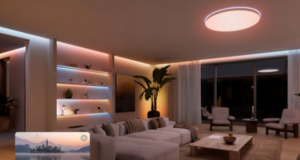
Doors play a huge design role not only based on their own appearance, but also in terms of the impact they have on the rest of your home and how it flows and functions.

Image courtesy of Stegbar.
It’s one thing to consider the practical nature of a door; its security, insulation properties and ease of maintenance all have their part to play. But doors are also chosen based on their appearance and style – how well they will suit the décor, and how they affect the feel and character of your home. Doors can have a dramatic effect on both the appearance and feel of a home, and can make the difference between a cosy and uncomfortable environment.
Types of doors
The type of door you choose will probably play the biggest role in how the door looks, how it makes your house look, and what choices of material will be available to you. Whether you choose a hinged or a sliding door or some variant on either will decide which way the door will have to open, and will give you an indication on where the framing should be installed.
Different styles of doors are associated with different styles of homes, and if your home’s designed to be faithful to the architecture of a particular era or style, choosing the wrong doors will both look wrong, and possibly affect the value of your home. The materials should also ideally be consistent with and complementary to the overall style of your home – while UPVC might be a very practical choice, it’s probably going to look wrong on many older styles of homes – just as a large, high-tech electronic keypad lock might.
There’s always a lot of wiggle room and nobody’s going to arrest you if the materials, door furniture and door styles aren’t perfectly in keeping with any one particular style of architecture, but it is important to consider how these things will affect the overall feel of your house.
Open and shut
It’s important to take into account how doors will look both closed and open, too. A closed glass sliding door, for example, may offer the same panoramic view as a set of glass bi-fold doors, but when folded back, the bi-fold doors will offer almost twice as much access through the rear entryway, which will most definitely change the dynamic in the room. Likewise, doors inside your home can have a significant impact on how spaces are divided and how light is allowed through.
The resting points of both hinged and sliding doors when they’re opened should also be taken into account – in most cases, an open door is still a large, conspicuous panel of material that rests inside a room. If you wish to conceal it, you may want to consider things like sliding doors that disappear into wall cavities (called pocket doors).
Colours and their impact
The psychology of colour and design theories relating to colour can take you down a very deep rabbit hole – as a basic rule though, remember that to make a smaller space appear larger, you should paint the trim the same colour as the walls or a couple of shades lighter, so as to make the corners blend in with the body of the house. In larger houses, space may be a less precious commodity, and you may wish to use bolder colours and contrasts to delineate the borders more strongly.
For outward facing doors, in particular the front door, don’t forget to consider the overall look of the house, in particular the roof and window frames, when choosing your colour scheme.





